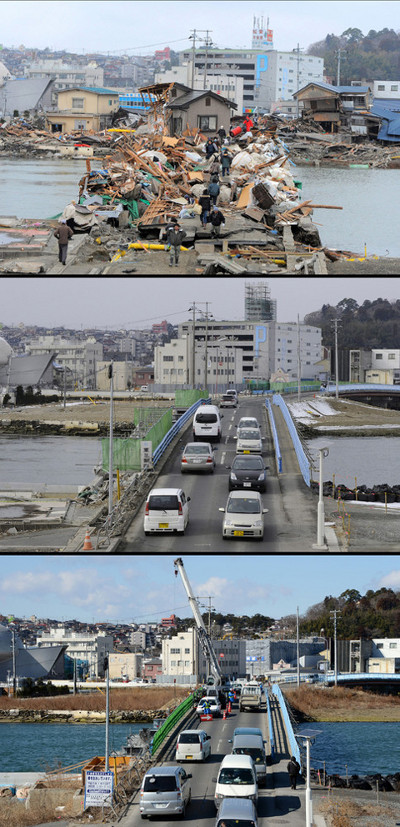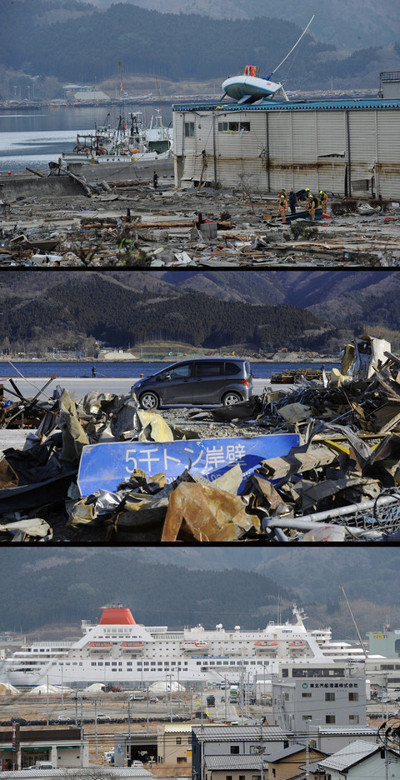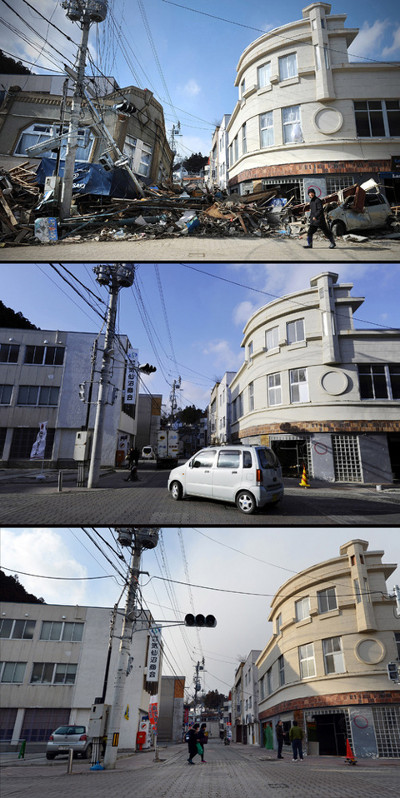Japan 2 years after the earthquake and tsunami disaster
On March 11, Japan will hold a memorial ceremony on the day of the earthquake and tsunami that killed more than 19,000 people . The government promised to promote restoration but the wilderness is still present in the disaster-stricken land.

Three photos taken at the bridge in Ishinomaki City, Miyagi Prefecture, which was devastated by the tsunami on March 15, 2011, January 13, 2012 and February 22, 2013. The rubble has been cleaned up, the houses have been repaired but the population is still sparse by fearing the effects of radiation. There is still much work to be done to restore the city just like before the disaster.

The streets of Ofunato, Iwate Prefecture, were engulfed by the tsunami in 2011 and are still disrupted in 2012 and now become a factory with a ship parked in the harbor. A 9-magnitude earthquake in the ocean on March 11, 2011 caused tsunami waves of up to 15 meters to attack the northeastern coast of Japan, devastating coastal cities and making nearly 19,000 people were killed.

Kesennuma Street in Miyagi Prefecture collapsed after the disaster has been restored to traffic lights, yet sparsely populated and the local economic situation has plummeted, doubling the difficulties for reconstruction work. .

The ship was washed up on the street in Ishonomaki, Miyagi, in March 2011, after two years it became clear. Salespeople began reopening the fish market that local fishermen caught from new ships.

However, the memories of the giant wave sweep through the village have not yet faded. Children still have nightmares, families still mourn the ill-fated relatives and a part of the east coast of Japan is still quiet.

The city of Rikuzentakata, Iwate, where the tsunami was devastated was neatly rearranged. The earthquake also led to the world's worst nuclear disaster since the Chernobyl incident in 1986, when tsunami columns knocked down the cooling system at the Fukushima nuclear power plant. The catastrophe affected the people's belief in nuclear power plants, which produce nearly one-third of Japan's electricity.

Chaos streets of vehicles and pedestrians in Tagajo, Miyagi, now tidy and orderly again.

The statue of the replica of the Goddess of Freedom at Ishinomaki in Miyagi has not been repaired yet. Some residents decided to move to higher lands to rebuild the town. Some others are hesitant, do not know how to arrange new life.

The Natori area, near Sendai in Miyagi, is heavily damaged by tsunamis and earthquakes through 3 photos taken on March 13, 2011, February 12, 2012 and nearly two years later on February 21, 2013.

A picture of a 10m high pine tree in Rikuzentakata, Iwate, survived the disaster. This is the only tree left out of about 70,000 trees planted on the coast to combat sand and wind salinity. However, after 2 years this pine tree also died.

The scenery outside Sendai Airport in Natori, Miyagi Prefecture over 2 years. Photographer Toshifumi Kitamura, who works with his colleagues to make the photo, said he was upset that the pace of recovery after the disaster was slower than he imagined and expected the work to be reconstructed more quickly in the future. hybrid
- Life inside the seawall in Japan 7 years after the double disaster occurred
- Japan still faces the risk of super-earthquakes
- Tsunami of tsunami in Japan
- Fukushima 7 years after nuclear disaster
- Earthquake triggers tsunami warning in Japan
- Strong earthquake in Japan, tram stops
- Japan revived, a year after the double disaster
- Japan suffers from a strong earthquake
- The 7.3-magnitude earthquake caused a small tsunami in Japan
- Earthquake in Fukushima, Japan power plant area
- Japanese tsunami garbage to Hawaii
- A 10-meter tsunami hit Japan
 The 11 most unique public toilets in the world
The 11 most unique public toilets in the world Explore the ghost town in Namibia
Explore the ghost town in Namibia Rare historical moments are 'colored', giving us a clearer view of the past
Rare historical moments are 'colored', giving us a clearer view of the past The world famous ghost ship
The world famous ghost ship